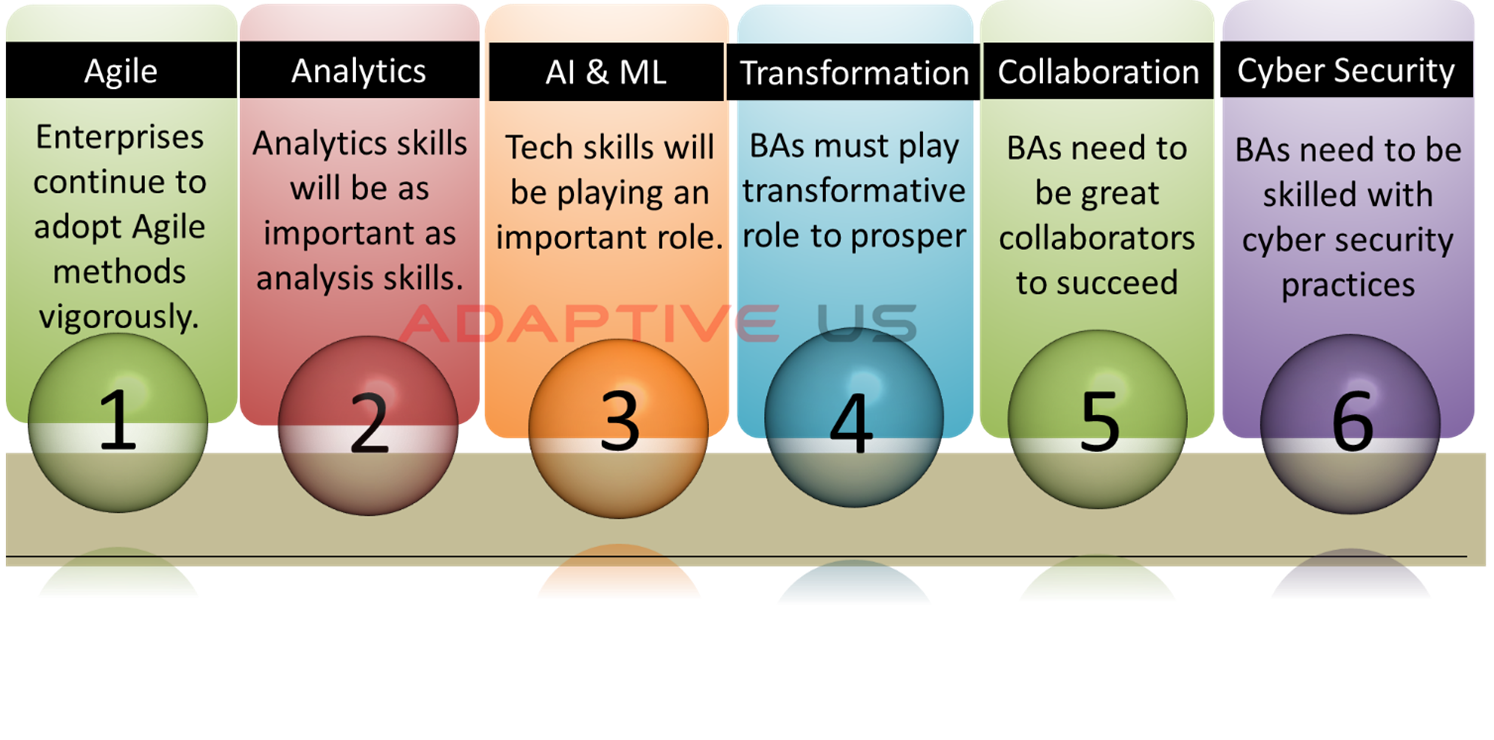Top Business Analysis Trends To Watch Out For In 2023
It’s tough to predict the future and same goes towards predicting business trends with certainty. But we can always predict areas which are likely to be of prominence with a fair amount of certainty.
As we all know business analysis is a profession growing at a fast pace and will continue to see this trend of growth for at least next 10 years. If you are a proactive business analyst you must keep watch on the trending topics to stay ahead of the curve and be a futuristic leader.
Here are our top 6 picks for business analysts to watch out in 2023 –

- Data Analytics:

Business analysts will continue to use data to have better business insights and drive business decisions. The amount and variety of data have increased tremendously in the last decade. Therefore, it is essential for business analysts to learn about data analysis tools. As data becomes increasingly important, business analysts will need to be proficient in advanced data analytics tools, techniques and be able to interpret and communicate the results to decision makers and stakeholders.
- Agile methodologies:

Over last few decades, more than 70% of companies have adopted Agile methodology for their project implementation, as a BA you just can’t afford to miss out on having a sound understanding of Agile concepts, principles, and culture!
This trend is here to continue and grow in 2023. Business analysts will need to be proficient with agile principles since many projects require them to double up as a scrum master or as a product owner.
Advertisement
- Artificial Intelligence and Machine Learning:

In simple words artificial intelligence and machine learning is the ability of machines to learn and carry out tasks based on the way it is programmed or instructed to do. It can analyze data and come up with decisions based on data and patterns. Many of the tasks carried out by AI and ML today are those where the inputs and the outputs can be well programmed or put out such as chat bots. Traditionally these tasks were handled by humans.
Some of the key benefits of using AI and ML are
- Improvement in efficiency
- Predictable performance
- Improvement in processing speed
- Reduction in human intervention for business processes
- Automation in process –
- finding patterns in process and reporting deviations
- reporting financial frauds
- supply chain improvements
- customer experience analysis and further recommendation
- Understanding customer behavior and suggesting products and services based on behavior and preferences
Business analysts are known to be the change makers and to be an efficient one they need to use technology efficiently to deliver better results and improve efficiency hence AI and ML is going to be their primary tech agents to achieve better business outcomes. Business analysts will need to be hands on with these technologies and their applications to make the most of it. They will need to understand how AI and ML can be used to automate processes, and achieve better business outcomes.
- Business Transformation:

Business analysts are the ones who primarily bring in business transformation by using technology effectively and as mentioned above AI and ML play a major part in this.
More and more organizations are embracing digital transformation than the past years, be it banks, financial institutions, service organizations or retail. Business analysts are the drivers playing a critical role in helping companies to identify and implement the changes needed to succeed. This might include business process changes, rethinking and redesigning business models, processes, and systems, and implementing new technologies to drive growth and competitiveness.
- Cross-functional Collaboration:

Business analysts often look at the organization’s internal as well as external facing processes with a critic’s eyes of improvement and redesign the processes to implement all those improvement ideas.
This often involves working with many functions, teams within the organization. They often need to use their power to influence to drive these change initiatives or process improvement initiatives.
This also requires coordinating as well working with various process owners and stakeholders to drive the initiatives to success.
- Cybersecurity:

With the increasing digital transformations across all sectors including those involving financial as well as highly confidential data, the threat of cyberattacks have gone up drastically.
Business analysts need to take into consideration the confidentiality as well as the risk and vulnerabilities involved in the applications while designing/solutioning the applications.
They need to be well versed with cybersecurity practices to design robust systems and processes.
They will need to be able to work with security experts to ensure that systems and data are protected from potential threats.
Overall, the trends in 2023 will continue to emphasize the importance of analytics, data, technology, automation, cyber security and collaboration in driving business success. Business analysts who are able to master the skills needed for these trends and implement them to succeed in a rapidly changing business environment will be well positioned for success.





